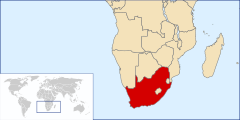This article needs additional citations for verification. (May 2017) |
  | |
| Continent | Africa |
|---|---|
| Region | Southern Africa |
| Coordinates | 29°00′S 24°00′E / 29.000°S 24.000°E |
| Area | Ranked 25th |
| • Total | 1,220,813 km2 (471,359 sq mi) |
| Coastline | 2,798 km (1,739 mi) |
| Borders | Total land borders: 4,862 km Botswana 1,840 km, Lesotho 909 km, Mozambique 491 km, Namibia 967 km, Eswatini 430 km, Zimbabwe 225 km |
| Highest point | Mafadi 3,450 metres (11,320 ft) |
| Lowest point | Sea level 0 m |
| Longest river | Orange River 2,200 kilometres (1,400 mi) |
| Largest lake | Lake Chrissie |
| Exclusive economic zone | 1,535,538 km2 (592,875 sq mi) |
South Africa occupies the southern tip of Africa, its coastline stretching more than 2,850 kilometres (1,770 miles) from the desert border with Namibia on the Atlantic (western) coast southwards around the tip of Africa and then northeast to the border with Mozambique on the Indian (eastern) coast. The low-lying coastal zone is narrow for much of that distance, soon giving way to a mountainous escarpment (Great Escarpment) that separates the coast from the high inland plateau. In some places, notably the province of KwaZulu-Natal in the east, a greater distance separates the coast from the escarpment. Although much of the country is classified as semi-arid, it has considerable variation in climate as well as topography. The total land area is 1,220,813 km2 (471,359 sq mi). It has the 23rd largest Exclusive Economic Zone of 1,535,538 km2 (592,875 sq mi).
The South African central plateau contains only two major rivers: the Limpopo (a stretch of which is shared with Zimbabwe), and the Orange (with its tributary, the Vaal) which runs with a variable flow across the central landscape from east to west, emptying into the Atlantic Ocean at the Namibian border.
The eastern and southern coastal regions are drained by numerous shorter rivers. There are very few coastal rivers along the arid west coast north of 31°30′S.
In such a dry country, dams and irrigation are extremely important: the largest dam is the Gariep on the Orange River.